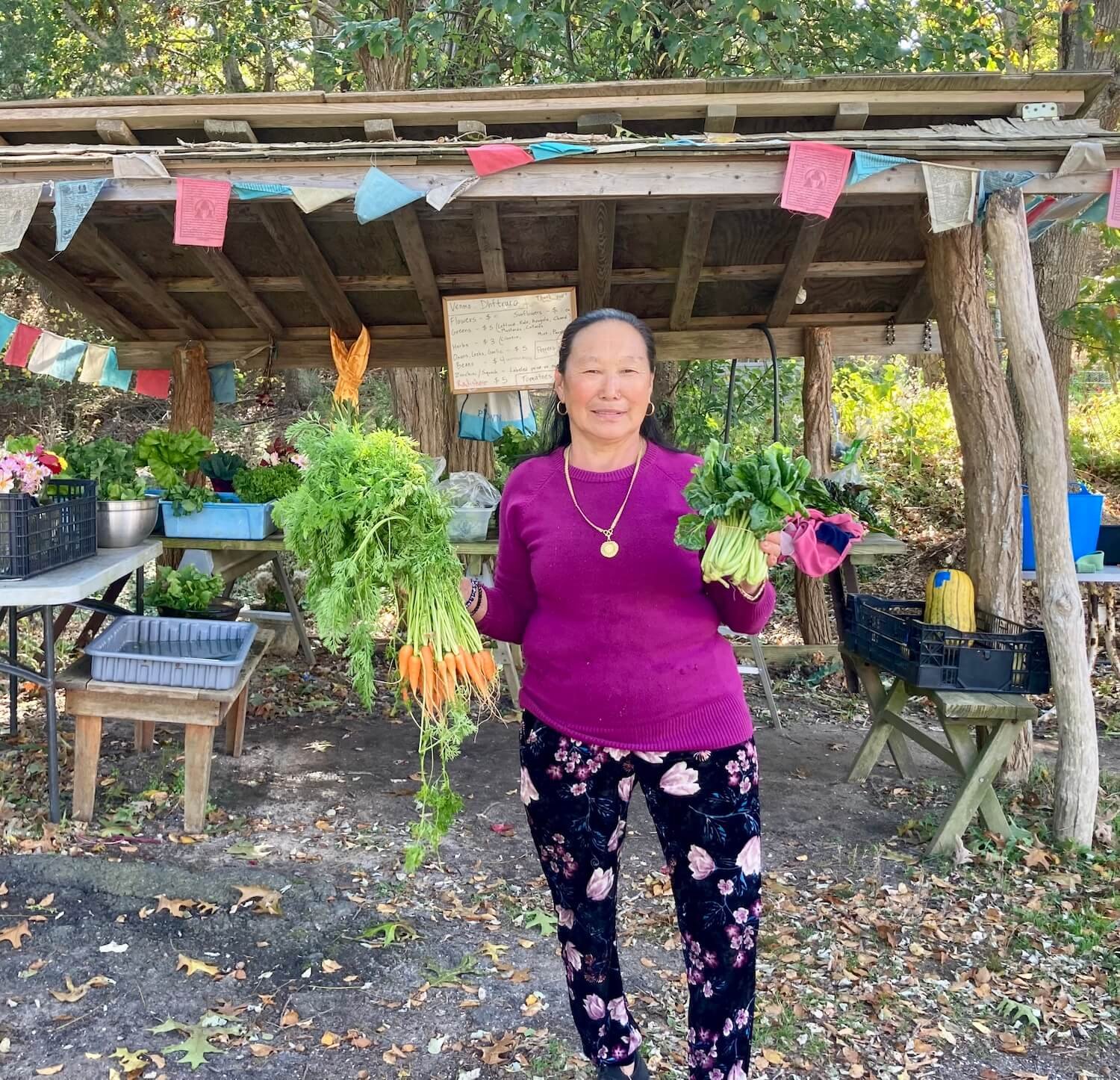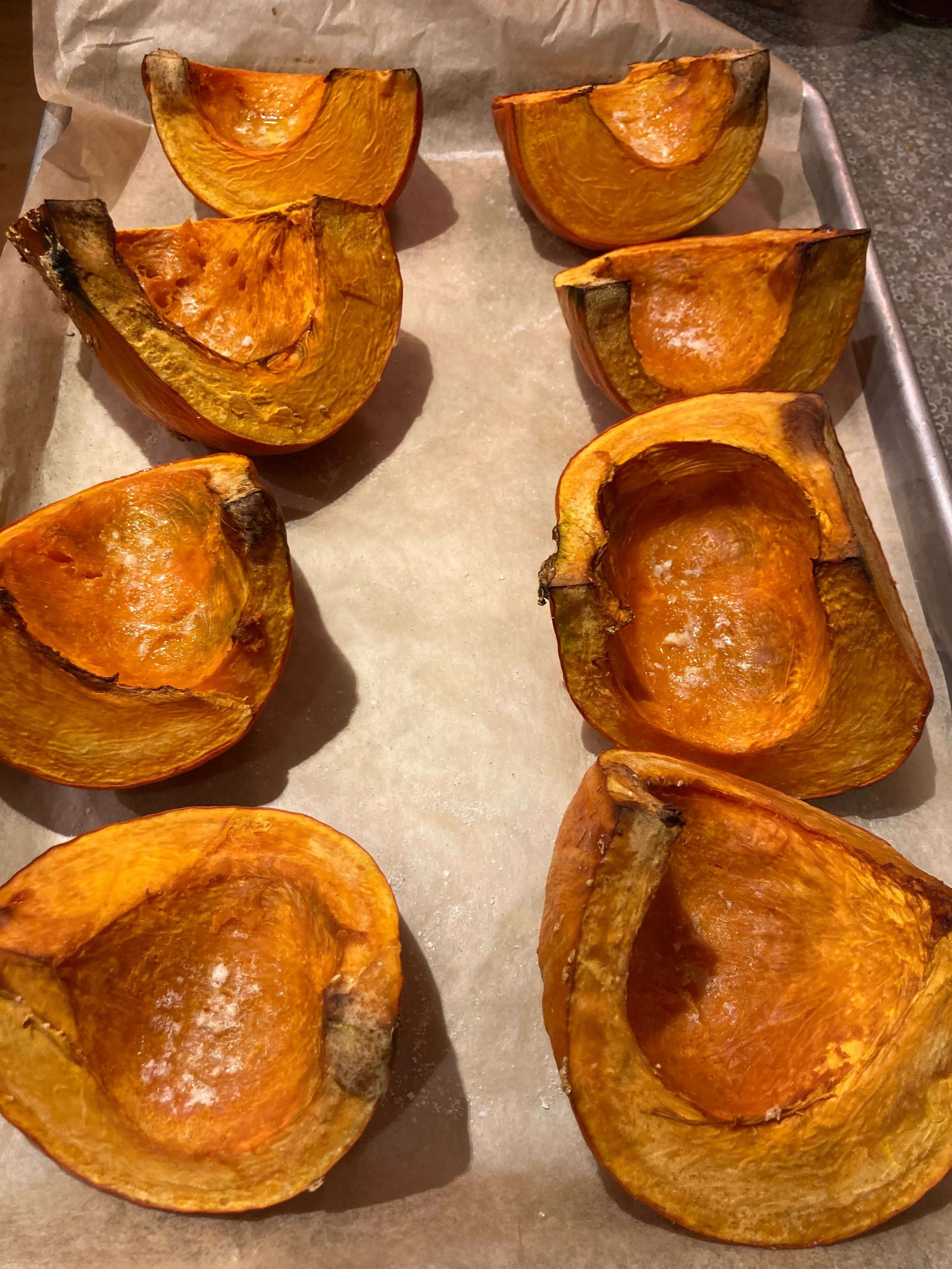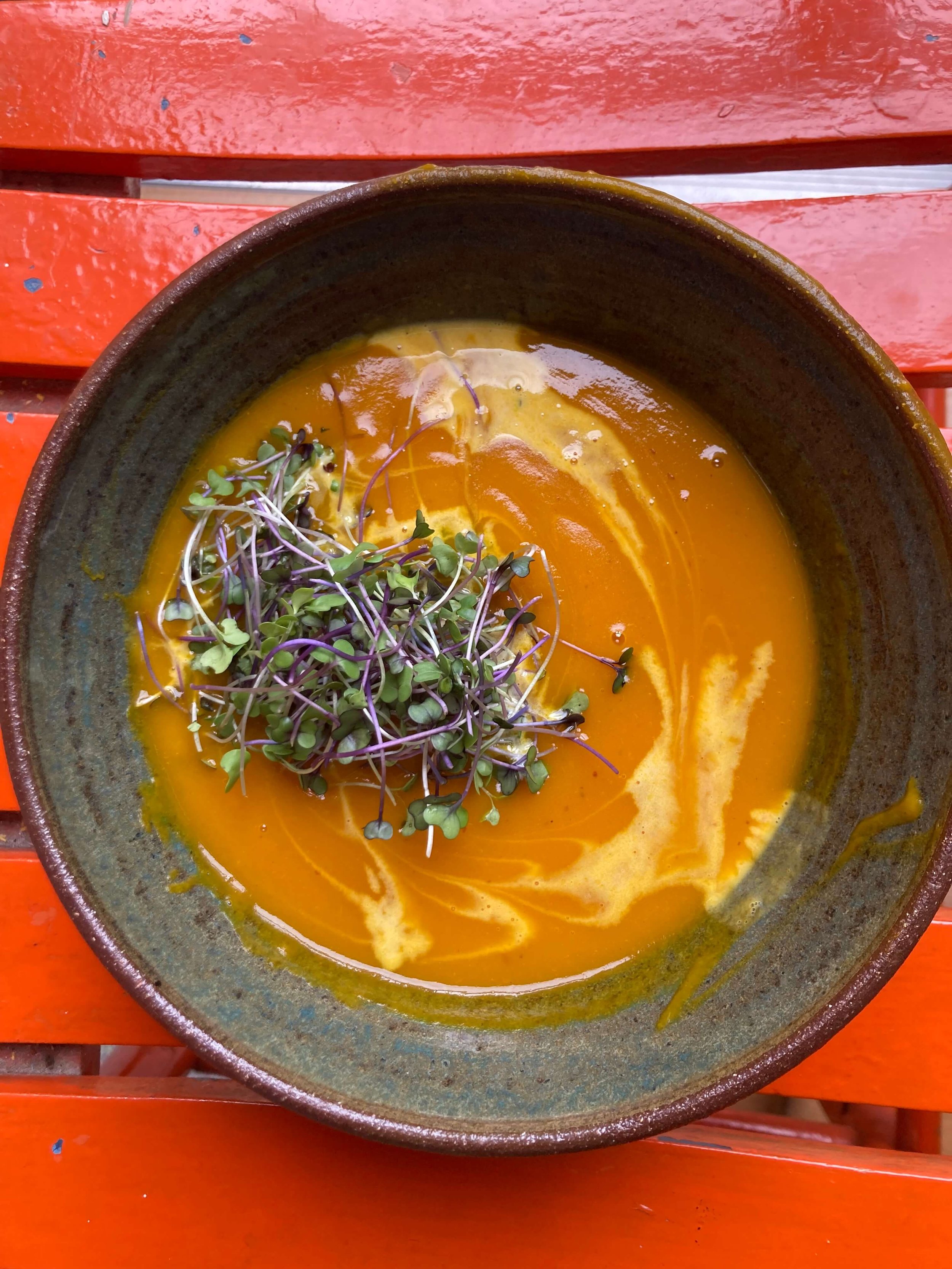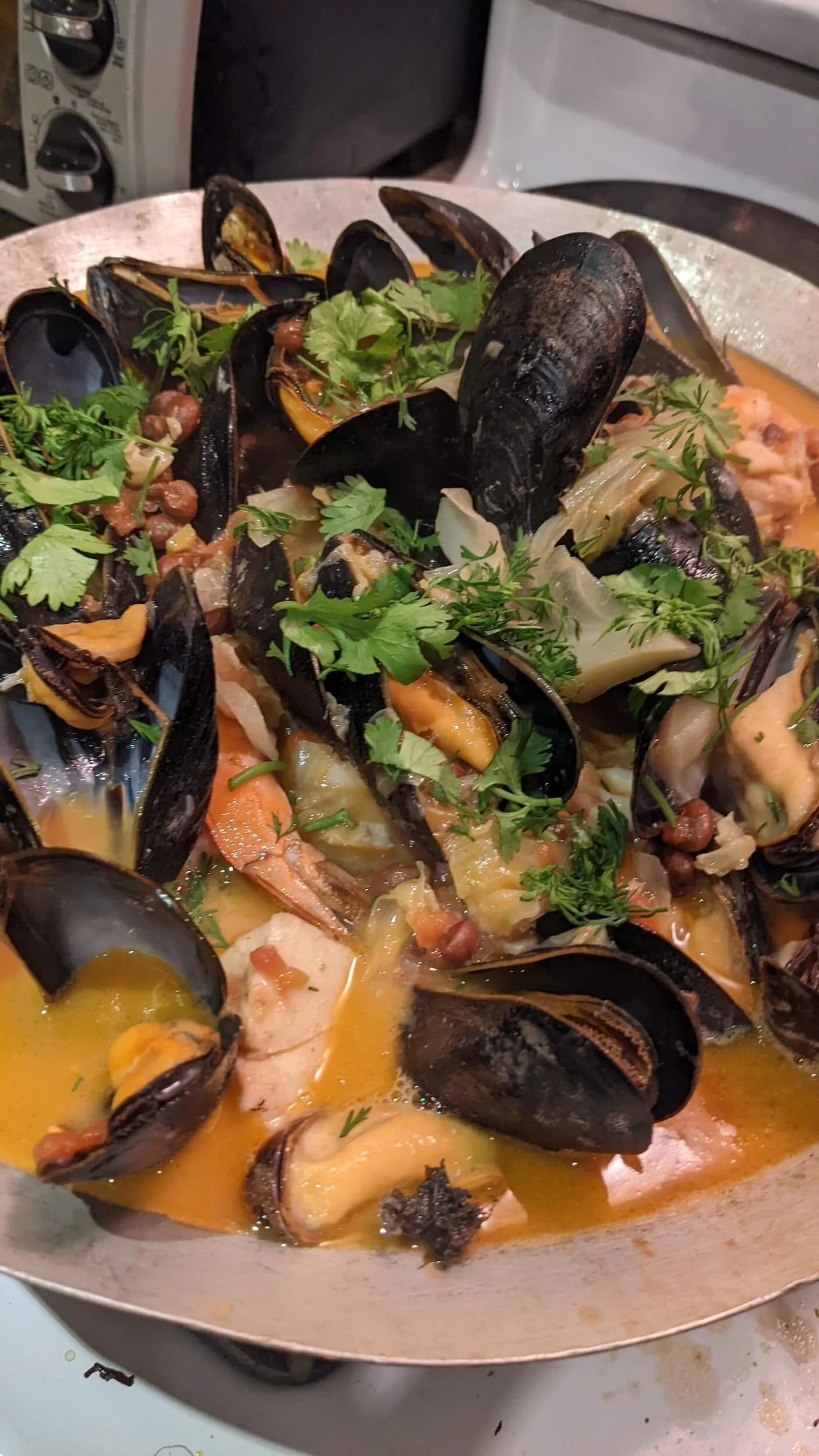
Recipe Inspirations
These are recipes which feed my body and soul. They are inspired by the seasons, my garden, travels and collaborations. I’ll be adding new items periodically so be sure to stay connected.
What recipes inspire you? Feel welcome to share your latest with me.
Lucette's Ratatouille
My mother wasn’t one for elaborate cooking. Most of the time, we were living out of our Volkswagen bus — before “van life” was even a thing — cooking on a Coleman stove or over a campfire. Meals had to be simple, from scratch but unfussy. Every once in a while, though, we’d have access to a real kitchen, and that’s when she would pull out recipes that took a little more effort. Her ratatouille was one of them.
Lucette’s Ratatouille
I remember watching her slice zucchini and eggplant into discs, salting and patting the eggplant dry, then frying each piece one by one in olive oil. She had her trusted Opinel knife — no cutting board, just her thumb pressed against the blade, slicing garlic straight into the pan in the way she always told us never to do. Into a heavy cast iron pot went the layers: fried eggplant, zucchini, peppers, onions, and tomatoes, left to simmer until everything melted into a rich, hearty stew.
The meaty texture was deeply satisfying, especially during those years when our family was vegetarian. It was rustic and earthy, yet somehow luxurious compared to our everyday meals on the road. For me, it was grounding, comforting — a dish I’ve learned to appreciate all the more for the effort it took. Over time, though, I’ve found my own shortcuts: roasting the vegetables instead of frying, letting the oven do the work, while still keeping the silky, sweet flavors intact. This time of year, it’s the perfect way to use up what’s still abundant in the garden. And if you’ve got more vegetables than you know what to do with, make a double batch — it freezes beautifully, and you’ll be glad to pull it out on a cold winter night.
INGREDIENTS:
1 large eggplant (peeled in stripes, like a cucumber)
2 medium zucchinis
1 large red or yellow pepper (I skip the green — I don’t like them cooked)
1 large onion
3–4 ripe fresh tomatoes
½ can (14 oz) crushed tomatoes, if needed for extra sauciness
6–8 cloves garlic, smashed or sliced
3/4–1 cup of good olive oil (don’t skimp — this is what makes it silky and sweet)
A handful of herbs: rosemary, marjoram, thyme, basil, or dried Herbes de Provence
Salt & pepper
METHOD
Preheat oven to 400°F.
Slice the vegetables into discs or chunks: eggplant, zucchini, onions, tomatoes, and peppers. Salt the eggplant generously, let it sit 20–30 minutes, then pat dry.
Spread everything across a sheet pans. Toss with lots of olive oil, garlic cloves, salt, and pepper. Roast until softened and caramelized — about 25–30 minutes.
Transfer the roasted vegetables (scrape up all the sweet, crispy bits too) into a Dutch oven. Add herbs and a splash of crushed tomatoes if needed. Drizzle with a little more olive oil.
Cover and bake at 375°F for 40–45 minutes, until the vegetables are meltingly soft and everything has come together.
NOTES
Tomatoes: If you’re using 3–4 fresh tomatoes, you don’t need much canned tomato — about half a can is enough to add body. Skip the canned entirely if you want a less saucy ratatouille.
Olive oil: Yes, it’s a lot — about a cup — but this is not the place to skimp. The oil mingles with the roasted vegetables, herbs, and tomatoes to create that silky, sweet richness that makes ratatouille so satisfying.
Serving: Traditionally it’s served as a side or with crusty bread, but in my family we love it over whole wheat pasta, topped with parmesan, ricotta salata, or even burrata.
Green Pie (G's Garden Spanakopita):
Another One of My Easy, Throw-It-Together Recipes... Obviously
Don’t overthink this! Below is my latest version of Green Pie. I make this regularly in all seasons using what greens I have available. Whether you have fresh garden greens, frozen kale/spinach or a combination of fresh & frozen, this pie always comes out delightful. Make it the thickness you desire. Potatoes add a density and sustenance but I’ve also successfully used mushrooms, sliced boiled eggs, tofu, or pine nuts and I love seasoning with z’atar, lemon zest, or goat cheese. This makes an awesome dish to bring to a potluck or party. Wonderful eaten hot as an appetizer or main meal, and also delicious at room temperature for breakfast or lunch. Kid-friendly and holds up well in the lunchbox (just sayin’).
I love filo dough because I’ve struggled so much as a baker making simple dough–it’s just not my thing. Pulling out filo dough from the freezer doesn’t bruise your ego…no one expects you to make it, and it’s easy to work with! Follow instructions on your package for added tips.
Visit Digree from Down Home Farm at her stand this fall (8 Truro Center Rd) for the best veggies around!
INGREDIENTS:
Filo dough (organic available)
Feta cheese (or non-dairy version)
2 eggs
Olive oil
Butter
1 bunch of kale
1 bunch of swiss chard
1 bunch of dill
2 leeks
2 cups of boiled & cubed potatoes
Sesame seeds (optional)
PROCESS:
Thaw out Filo Dough
Wash & dry greens. Wash and thinly slice leeks. Chop greens–stems & leaves.
Sauté leeks and stems of greens in a combination of olive oil & butter.
Add greens and cook down.
Set leeks & greens aside in a bowl to cool.
While the greens are cooling, boil potatoes. Once cooled, slice into ½ inch cubes or slices. Set aside.
Once greens are cool, squeeze excess water out of them, if necessary. Add eggs and feta cheese, potatoes, mix, and season to taste. Consider the saltiness of feta cheese when seasoning.
Chop fresh herbs and add to the mixture.
Mix well!
Melt ¾ stick of butter in a small saucepan. Set aside.
Preheat oven to 350 degrees F
Time to assemble! In a 9 x 13 pyrex dish, layer one sheet at a time of filo dough and brush melted butter between each sheet. 5 sheets layered on the bottom is great. Throw your mixture on top of filo dough, spread evenly, and add another 5 layers of filo dough. Be sure to brush melted butter between each sheet. Wa-LA!
Sprinkle with sesame seeds, if you like.
Place in the hot oven and bake for 25-30 minutes.
Let the pie cool if you can…and enjoy!
Birria
Alejandra with toppings for Birria
I’m excited to share this delicious recipe that Alejandra, our wonderful cook at Baja Serenity, prepared for us last winter. Accompanying the recipe are beautiful photos and a delightful short video by Leti, our talented videographer. Please enjoy watching!
This birria recipe is a lighter version of some I've seen, making it perfect for a taco party this summer. Many of the accompaniments Alejandra served can easily dress a grilled fish taco for non-meat eaters. Make some salsa and guac, and you’re all set for a crowd-pleasing meal. The pride and love Alejandra has for her work shine through in every dish, as she shares her cherished Mexican culinary heritage. If you put as much love into it as Alejandra did, your guests will certainly want to come back for more.
Just as I am excited to return to Baja Serenity next winter for more incredible food and fun. Check out the Retreat Page!
INGREDIENTS:
3.5 kg beef (neck and ribs)
15 guajillo chiles
5 tomatoes
2 cloves of garlic
1/2 onion
2 small sticks of cinnamon
Approximately 6 cloves
1 teaspoon of cumin
1 tablespoon of oregano
1 tablespoon of black pepper
100 g of sesame seeds
2 bay leaves
A pinch of chicken bouillon powder (Knorr Suiza)
3 tablespoons of white vinegar
4 liters of water
PREPARATION:
1. Boil the guajillo chiles, tomatoes, onion, and garlic in water until soft.
2. Blend the boiled ingredients with cumin, cloves, bay leaves, oregano, pepper, cinnamon, and a pinch of chicken bouillon powder.
3. In a large pot, place the meat and pour the sauce over it. Mix well until the meat is completely coated with the sauce.
4. Add the white vinegar and 4 liters of water. Bring to a boil and simmer for 20 minutes. If necessary, add an extra 1 or 2 liters of water to prevent the meat from drying out.
5. Season with chicken bouillon powder to taste while stirring the meat and sauce.
6. In a separate pan, toast the sesame seeds until golden brown.
7. Add the toasted sesame seeds to the pot and let the birria finish cooking for about 1 hour or 1 hour and 30 minutes, until the meat is so tender that it easily separates from the bone.
8. Serve accompanied by your favorite taco toppings, corn tortillas, rice, and, of course, all that fabulously fragrant broth.
Torta di Grano Saraceno (buckwheat)
In the Dolomites, Paul and I stayed at a sweet, family-run B&B, Hotel II Cardo, located in San Vito di Cadore. Owned by the Favero family, mother Guiliana and father Roberto run the kitchen, and their twin daughters, Marika and Valentina, take care of the front of the house. The accommodations were lovely, the mountain views magnificent, and the food quite satisfying.
Marika and Valentina, Hotel II Cardo
Each morning began with a large buffet breakfast with choices of eggs, meats, cheeses, yogurts, fruits, cereals, and an impressive spread of pastries and baked goods. During the first couple days I overlooked the pastries, not giving them much thought, until I noticed they were baked by Roberto and coming out of the kitchen fresh and hot. A dark, dense, rich-looking cake caught my eye and, after inquiring about it, I was pleased to hear it was a Buckwheat Hazelnut Torte with a wild cranberry jam.
Having grown up in Québec, buckwheat is a common staple, and I was raised eating Galettes de Sarrasin, which are flat thin crêpes cooked directly on a woodstove with buckwheat flour, baking soda and water, and served with salted butter and molasses. Every culture has its own unique variation on basic foods, typically dependent on what ingredients are readily available, and for us French Canadians, buckwheat is it. In this recipe, when combined with hazelnuts, buckwheat’s nutty flavor is wonderfully enhanced. After a few bites, you might just realize that this torte is ideal for just about any holiday affair! And to top it off, buckwheat is unrelated to wheat, naturally gluten-free, and remarkably nutrient-dense.
Torta di Grano Saraceno (buckwheat)
INGREDIENTS
250 g buckwheat flour
250 g butter
250 g sugar
250 g hazelnuts
6 eggs
1 tsp. baking soda
1 tsp. cinnamon
Jam of your choice (classic jams in the Dolomites are made with wild cranberries & wild blueberries)
1. Make the measurement conversions or use a scale.
2. If you don’t have a jam that you love, make one!
3. Preheat oven to 325 degrees.
4. Butter a 10-inch springform pan and line with parchment paper.
5. Grind hazelnuts in a food processor until fine.
6. In a standup mixer, mix butter and sugar until creamy and then add eggs one at a time while slowly mixing. A fluffy consistency is desired.
7. Add ground hazelnuts and continue to mix lightly.
8. Add the remaining dry ingredients and mix thoroughly.
9. Pour batter evenly into springform pan using a rubber spatula.
10. Bake for 45-55 minutes, or until you can pierce cake cleanly.
11. Let the cake cool on a rack…don’t be tempted to cut into it until it has fully cooled and settled.
12. When cool, slice cake across the middle horizontally.
13. Evenly spread your jam of choice and re-assemble cake.
Now it’s ready to eat! Enjoy with plain yogurt in the morning or perhaps a dollop of unsweetened whipped cream with your afternoon or evening tea.
I’ve been so into this nourishing cake. The consistency is divine and the flavor is rich, earthy and extraordinarily nutty. Buckwheat is definitely an acquired and particular taste, yet the tartness of the cranberry jam combined with the sweet buttery richness will make you savor each morsel and go back for more!
One more thing: how awesome would it be if you made a jam depending on what fruit is in season. Right now on the Outer Cape, wild cranberries are bountiful for foraging, and this past summer, we collected wild blueberries, black raspberries, blackberries, and many other outstanding wild and locally-grown fruits. Think of peach jam, pear or plum jam, mmm so many possibilities to make this cake a perfect marriage of the Italian Alps culinary culture and your own home-grown delight.
Omelettes On My Mind
Growing up with little resources, my family typically had a few staples in the fridge: eggs, bread, milk, and, depending on the weekly budget, butter. It was always just enough for my dad to cook up a delicious French omelette and fill everyone’s bellies. And it wasn’t just any omelette, my dad was greatly inspired by the renowned French Chef Paul Bocuse and his legendary cookbook. When he had extra cash, dad would toss in cheese, mushrooms, asparagus or leeks; on special occasions (or when he was trying to impress), he would stuff it with a seafood béchamel sauce. By observing my dad make omelettes, I got the overall jist of what the process entailed, yet it wasn’t until I watched my man Jacques Pépin on PBS that I realized woah, there is a real art to making a fine French omelette.
With this lovely spring weather, my love for omelettes has resurrected. Fresh local eggs are readily available, my garden herbs are coming to life, and asparagus spears are quickly breaking through the ground—it’s the ideal time to make a simple and scrumptious omelette. Additionally, it’s easy to find some hearty spinach or leeks, and if you are out there foraging, be sure to keep your eyes open for fiddleheads and ramps (aka spring leeks).
I’m not giving you a specific recipe here, but rather sharing my delight of two classic French chefs, pillars of my childhood, as well as a current young chef that I recently discovered on Youtube. If you haven’t watched Alex Aïnouz on Youtube, it’s worth ten minutes of fun and laughter.
Here are a few of my favorite omelette combinations:
Classic fresh herbs (chives, tarragon, parsley)
Asparagus and gruyère
Smoked salmon and crème fraîche
Mushroom and leek
Hollandaise and poached lobster
Along with the best ingredients you can find, be sure get yourself a quality non-toxic PFOA-free pan. Teflon may give you that perfect visual but eh, it’s not worth the compromise.
Hope you have some fun playing around with these combinations. Don’t get too serious or bogged down in perfection—you’re not being graded on this. Enjoy! Bon Appétit!
Mayra's Family Picante
On the recent trip I took to El Cuyo, I had the pleasure of tasting some delicious Yucatán specialties. As we know, cooking is based on traditions and rituals. Every region in Mexico has its own take on tamales, and every household has its favorite recipe for a spicy table condiment. This picante is a simple recipe that was served alongside all the food we ate at Utopia Guesthouse. The food, prepared and served by Durkey, Sandra and Mayra, was a delight to savor. These lovely women also taught us how to make their traditional tamales and gave us an opportunity to make our own unique fillings. For the tamales recipe, you’ll need to visit Utopia Guesthouse, but here’s the recipe for Mayra’s Family Picante. Its up to you how spicy, salty, oily you choose to make it! Buen Provecho!
INGREDIENTS:
12 Habanero peppers
Up to 1 cup of Olive Oil
Generous amount of Salt
6 cloves of Garlic
Burn Habaneros and garlic cloves on a comal (or dry-pan).
Using gloves, remove all stems and seeds from the peppers. If you enjoy spicy heat, keep some seeds.
Put peppers, garlic, salt and olive oil in a blender. Blend until consistency is similar to a very loose & oily pesto.
Serve on rice, beans, veggies, fish, meat, eggs, everything.
Simple Warming Squash Soup (with very few ingredients)
If you regularly buy and cook winter squash, you know butternut and acorn squashes are easily available most of the fall and winter months. Right now, at your local farmers’ market or grocery store, look for something different—perhaps a plump kabocha or a sexy delicata squash. Kabocha is my fav.
Cook with confidence—you can’t go wrong with this soup! If it needs more liquid, add water or stock. If you feel you want more of a kick, add some extra spice. You get the drift. The trickiest part of the whole process is cutting the squash. If you don’t want to deal, feel welcome to roast the entire squash as is, however, I do feel the squash takes on a sweeter and nuttier flavor when you cut & roast rather than roasting it whole.
INGREDIENTS:
1 large squash of your choice
2 tablespoons butter or coconut oil
1 large onion chopped (type of onion your preference)
2-3 cups water or stock
1-2 heaping tablespoons of thai curry paste (depending on your desire for heat)
1 can of coconut milk
Salt & pepper to taste
1. Preheat oven to 375 degrees. Slice squash into quarters if you choose, or roast squash whole. Bake until you can easily pierce with fork or knife.
2. Chop and sauté onion in butter or coconut oil in big soup pot.
3. Scoop out roasted squash and add to pot.
4. Add water or stock. Bring to boil and simmer for 10-15 minutes.
5. Cool and pour soup into blender OR use a handy immersion blender. Blend away!
6. Once you are satisfied with your smooth purée, add coconut milk and thai curry paste. Heat, simmer, stir and taste. Add salt and pepper. Feel free to adjust flavors and consistency to your liking.
I ended up adding extra coconut cream to soup and then garnishing each bowl with microgreens. Garnish ideas: chopped cilantro, chives, arugula, roasted pumpkin seeds or sunflower seeds. Enjoy your unique version of this Simple Warming Squash Soup!
Inspired by Heridade da Matinha’s Seafood & Bean Stew
This is a great recipe…make it for a group of friends. Serves 8-10 people with appetites.
INGREDIENTS:
4-6 tbsp. butter
4 6 tbsp. olive oil
2 quarts of fish stock (homemade or store-bought, preferably not the boxed)
3 fat leeks
6 cloves garlic
2 stalks lemongrass
2 tbsp. minced ginger
6 cups of cooked white beans
1 large can of diced tomatoes
1 tbsp. (or to taste) fish sauce
2 pounds of local meaty white fish (halibut, monkfish, cod, or bass, any combination)
12 shrimp
1 pound of squid
24 mussels
2 cups green cabbage, cut into ½ inch chunks
1 can of coconut milk (or more to taste)
In a large pot, sauté garlic, ginger and leeks in butter and olive oil. Pound and bruise lemongrass stalks. Add lemongrass and then tomatoes. Cook on low heat for 5 minutes so flavors concentrate. Add fish stock, cooked beans, and cabbage to the pot. Add fish sauce and taste. Simmer for at least 30 minutes while you are preparing fish.
In a separate pan, in butter and olive oil cook seafood in small batches so as not to over-crowd the pan. Gently flip to get a light sear on all sides, careful with the white fish as it will crumble once it starts to cook. Season to taste with salt and pepper. Deglaze pan with the white wine you are drinking. Place aside.
Add mussels to stew pot until they open. Turn off heat. Add coconut milk and all the fish. Stir and taste. Garnish with freshly chopped cilantro.
Serve with a big green garden salad and a good bottle of Portuguese wine.
I made this stew the other night for a group of friends and it was deeply enjoyed by all. Like my other recipes, this is an opportunity to be creative in your kitchen and use what you have available locally. I had squid and fish stock in my freezer and bought what fish looked freshest at the local market. I could have easily used littlenecks, scallops, lobster, or other white fishes. The flavor combinations may sound strange, but trust me, this is scrumptious. Give it a try and tell me what you think! G
A Hearty Broccoli & Mushroom Loaf
This recipe is adaptable. You may use other vegetables (cauliflower, zucchini, asparagus, kale) and mushrooms of your choosing. The trick is combining the right proportions of the binding ingredients (eggs & cheese). I used a combination of rice and lentils, but you may easily use millet, farro, quinoa, white beans, fava beans, or any other grains/legumes of your choice. I served this with a Mornay sauce (cheesy béchamel sauce) because I had an excess of cheeses and milk. You may want to make a simple tomato sauce with herbs and garlic to dress the dish. Here in Truro, I was fortunate to find Down Home Farm’s fresh eggs and Uli’s fresh oyster mushrooms. Visit your local farmers’ market, farm stands or co-op if you are able. If not, use what you might have laying around wanting to be used in your fridge or freezer.
INGREDIENTS:
6 cups of assorted cooked grains & legumes
12 ounces feta cheese (or 12 ounces of cheddar & gruyère mixed)
4 eggs
½ pound of sliced mushrooms
1 head of broccoli
olive oil or butter
3 cloves of garlic
½ onion
salt & pepper to taste
First, cook grains and legumes according to their individual instructions. Cook grains and legumes separately to ensure proper cooking of each.
Preheat oven to 350 degrees and gently season a baking dish with butter or olive oil.
Next, cut broccoli into florets, blanch, and set aside to cool. Sauté sliced mushrooms, minced garlic and diced onions with olive oil or butter. Once everything is cooked and cooled, combine all ingredients in a large mixing bowl. Crumble feta cheese (or other cheese mixture) and add. Mix everything together in the bowl (before adding the eggs) taste the mixture and add salt, pepper, and any fresh herbs to your liking. Crack and lightly beat eggs in a separate small bowl. Add beaten eggs to large mixing bowl and stir all ingredients thoroughly. Add mixture to baking dish and bake in oven for approximately 30 minutes (or until eggs are thoroughly cooked).
I am giving you a very loose recipe here in hopes that you may get comfortable improvising with what you have on hand rather than running to the grocery store in search of every specific ingredient. Play around and have fun.
Give this delicious fresh juice a try! Not only will this nutritious beverage benefit your immune system and bring you refreshing hydration, it will boost your spirits and bring cheery brightness on these gloomy winter days. Packed with vitamin C, a variety of antioxidants and enzymes, this Pineapple Cranberry Ginger juice is easy to make with a juicer, blender or VitaMix. If you choose to use a blender or VitaMix instead of a juicer, be sure to strain the juice with a cheesecloth or nut milk bag. You may also want to add a little water when blending the ginger. Any kind of juicer, however, should be able to juice pineapple, cranberries and fresh ginger without adding water.
Fresh, organically-grown pineapples, cranberries and ginger roots are typically available at any regular grocery store. If you live on the Cape or in an area with bogs, look around for locally-grown or locally-harvested cranberries. Finding frozen cranberries at the store is always an option as well. Juice or blend, and enjoy this healthy, sweet treat!
Ingredients:
2 fresh organic pineapples
1 lb (16 ounces) fresh or frozen organic cranberries
Thumb-size chunk of organic ginger
Local Cranberries / Painted Bowl by Nancy Whorf / Leela’s hand
Pineapple Cranberry Ginger Juice / Painting by Chet Jones
The first time I had a version of this soup was when I was pregnant with Esmé and we went to Lucca in Tuscany, where this soup is a staple in the area and on the menu. It has become a favorite in my household this time of year… a riff on Mark Bittman’s NY Times recipe.
Here are some of my local garden/farmers’ market/fridge accommodations…
with some key ingredients!
I like to purée half or more of the soup before adding my favorite greens… whether it be fresh kale, swiss chard, spinach, collards, calaloo, or broccoli rabe.
Purée until you find the consistency you like.
Last time i made this, I soaked some of the Albulbia Blanca’s beans from Rancho Gordo. This small heirloom bean loves tomatoes + garlic and doesn’t require as much or any pre-soaking.
The abundance of tomatoes has been glorious in our garden this summer and early fall. If you have some fresh tomatoes available to you, roast them before using in the soup for deeper flavor. Find the freshest, organically-grown local food you can. I always have roasted garlic on-hand bc it is easier for me to digest. we have been blessed with a plump harvest of garlic this year in our gardens (and we are always looking for more local garlic seed).
The gardens and farms have provided us with a fruitful harvest… and it continues. Many of these ingredients can still be found at your local farmers markets.
Thank you farmers, thank you earth.
Cook with love + enjoy!
Tuscan Farro Soup
Inspired by Mark Bittman’s NYTimes recipe
2 tablespoons extra virgin olive oil
1 large onion, sliced
2 celery stalks, trimmed and chopped
2 carrots, peeled and chopped
Salt and pepper
1 tablespoon minced garlic
1 cup farro
1 cup dried white beans, soaked for several hours or overnight
2 cups chopped tomatoes (canned are fine; fresh or roasted preferred; do not drain)
6 cups stock or water, more as necessary
¼ cup chopped fresh parsley
¼ cup chopped fresh basil
Freshly grated Parmesan
Put olive oil in a large, deep saucepan over medium heat. Add onion, celery, carrots, a decent pinch of salt and some pepper. Cook until vegetables are glossy and onion is softened, 5 to 10 minutes. Add garlic, farro, beans, tomatoes and stock, and stir.
Bring to a boil, then adjust heat so soup is simmering. Cook until farro and beans are tender, at least an hour, adding stock or water as necessary if mixture becomes too thick. Stir in parsley + basil in addition to fresh greens (kale, Swiss chard, spinach, etc), and cook another 5 minutes. Taste and adjust seasoning. Serve with lots of Parmesan.
A bunch of blanched garlic scapes
A bunch each of flat leaf parsley, cilantro + dill
5-8 hot peppers of your choice (dependent on heat)
Zest of 3 lemons
Juice of 3 small lemons
A good handful each of dried coriander seeds + dried cumin seeds
1 1/2-2 cups of quality extra-virgin olive oil
Sea salt
Lightly toast cumin + coriander seeds. Take out ribs + seeds in each hot pepper. You can use your beautiful mortar + pestle to grind seeds or, to simplify, use an electric seed grinder. Then throw all ingredients into your food processor. Salt to taste. This recipe is inspired by a North African green sauce called Zhoug. Find local herbs and scapes at your local farmers’ market. Tastes great on grilled fish, eggs, roasted potatoes, etc. or as a marinade. Give it a try on this veggie burger.
101 Cookbooks
101 Cookbooks is a California food blog by Heidi Swanson, focused on healthy recipes for everyday. It features over 700 vegetarian recipes, whole foods recipes, and vegan recipes, plus the occasional sweet treat.

























